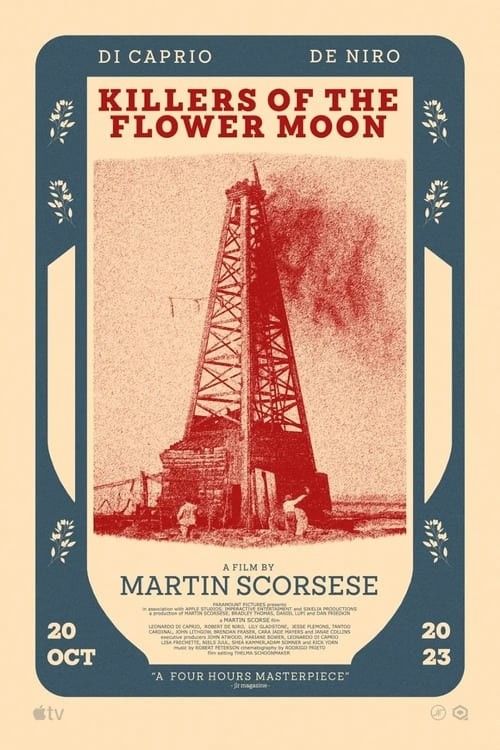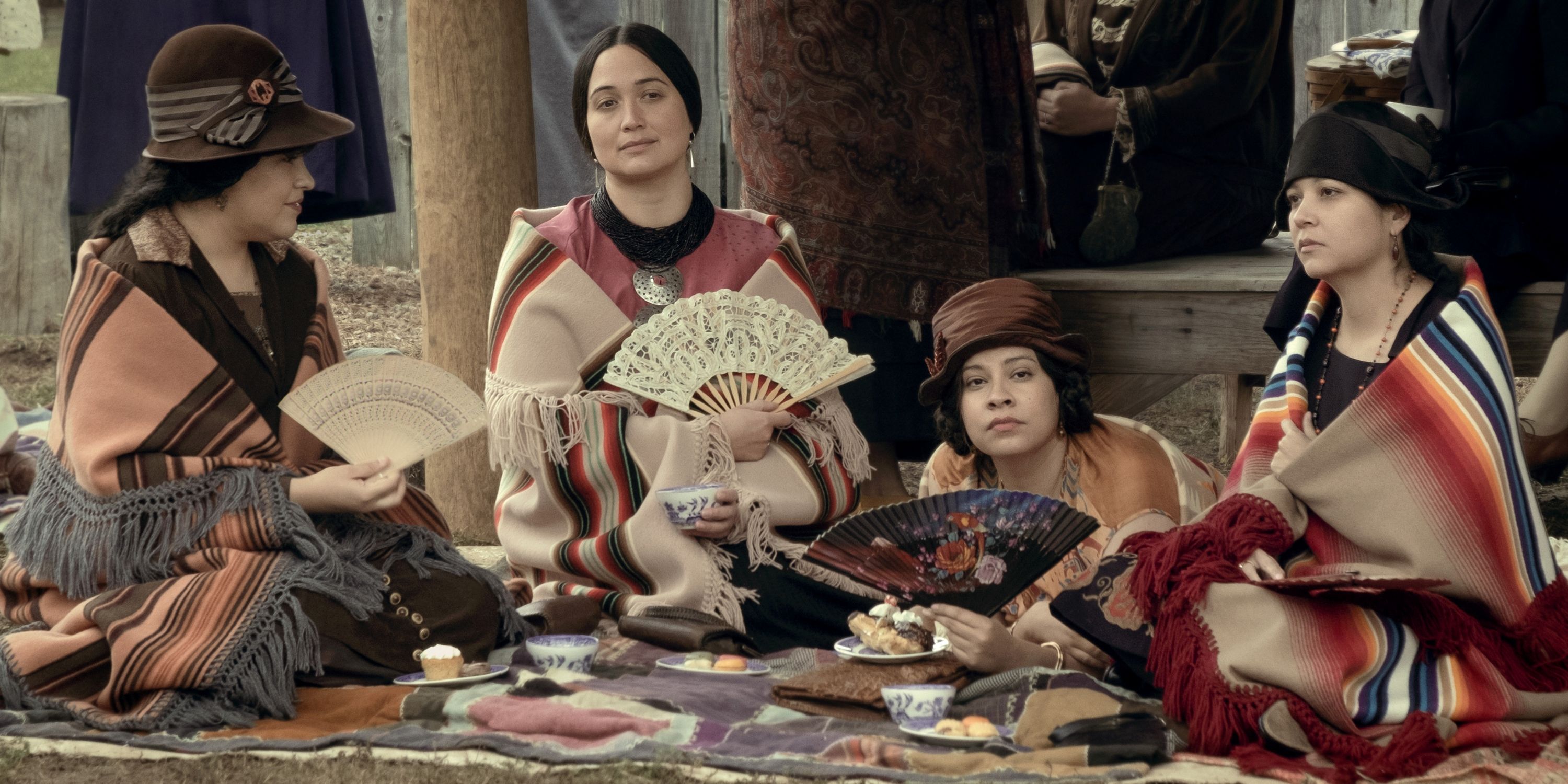
Unveiling the Dark Side: Assessing the True Crime Elements in 'Killers of the Flower Moon'

Martin Scorsese's 'Killers of the Flower Moon' defies the typical true crime narrative, rejecting the 'whodunit' formula It explores the victims' perspective, challenging the negligence often seen in true crime portrayals Expect no sense of justice or triumph in this thought-provoking historical epic
Article Summary
The rise of true crime media has desensitized audiences to the horrors of violent crimes, focusing more on the "whodunnit" aspect than the true horror and despair.
Martin Scorsese’s Killers of the Flower Moon breaks away from genre clichés by focusing on the complex dynamics between Ernest and Mollie Burkhart, rather than relying solely on a traditional investigation. By shining a light on the victims, the film confronts the problematic trend of glorifying killers and exploiting violence for entertainment purposes.
During the past decade, the true crime genre has experienced an unparalleled surge in popularity. Podcasts such as Serial and documentary series like Making a Murderer have successfully made gruesome subjects more accessible to a wider audience. Various streaming services have produced narrative miniseries that adapt real-life crimes, creating a constant source of content. While some cultural critics may analyze this phenomenon in depth, the prevalence of true crime media seems to have desensitized viewers to the horrific nature of murder and other violent crimes. Engaging audiences by encouraging them to develop their own theories about the culprits behind these crimes has become a simple yet effective way to captivate them. Unfortunately, this focus on the element of mystery often detracts from the depiction of the actual horror and despair associated with violent crimes. In contrast, the new Martin Scorsese historical epic, Killers of the Flower Moon, offers a refreshing departure from the genre's tired clichés.
Based on a true crime book of the same name by David Grann, Killers of the Flower Moon recounts a series of suspicious murders of members of the Osage tribe in Oklahoma, following the discovery of oil beneath their land. The book also explores the establishment of the Federal Bureau of Investigation and the ascension of J. Edgar Hoover, paralleling the investigation conducted by agent Tom White into the Osage murders. Grann's book is meticulously researched, presenting a complex narrative filled with numerous individuals and events. Despite these complexities, Killers of the Flower Moon reads with the smoothness of a mystery novel while maintaining its disturbing central thesis: how was this horrifying crime concealed from the public eye for such an extended period of time?
Killers of the Flower Moon depicts a horrifying tale set in the 1920s Oklahoma, where the riches of oil are found underneath Osage Nation land. As the Osage people embrace their newfound wealth, a series of gruesome murders plague the community, targeting them one by one. However, with the intervention of the FBI, the baffling enigma begins to unravel, exposing a web of secrets and bringing justice to those responsible.
Martin Scorsese Made a Pivotal Change in the Perspective of 'Killers of the Flower Moon'
Release Date: October 20, 2023
Director: Martin Scorsese
Cast: Leonardo DiCaprio, Robert De Niro, Lily Gladstone, Jesse Plemons, John Lithgow, Brendan Fraser, Tantoo Cardinal, Cara Jade Myers
Rating: R
Genres: Drama, Crime, History
Scorsese, in collaboration with Eric Roth, co-wrote the film adaptation of Flower Moon. They initially planned for the film to follow the perspective of Tom White, but Leonardo DiCaprio, Scorsese's muse, questioned the true essence of the story. After further consideration, Scorsese and Roth had a realization that the film should focus on the complex relationship between Ernest and Mollie Burkhart. An Osage woman's statement about their love sparked this epiphany. With DiCaprio as Ernest and Lily Gladstone as Mollie, Killers of the Flower Moon took on the distinctive qualities of a Martin Scorsese film.
Scorsese emphasized during a press conference at the Cannes Film Festival that the audience is aware that the film is not a typical murder mystery, but rather a question of who didn't commit the crimes. Evil is a pervasive force throughout the narrative, with William Hale, Ernest's uncle, being the embodiment of this malevolence. Scorsese removes any sense of mystery by revealing that Hale is behind the conspiracy of murders. He portrays Hale as a domineering figure who poses as an ally to the Osage people while carrying out his heinous acts. In the Deadline interview, Scorsese affirms that the audience knows Hale is a villain, eliminating the need for a traditional mystery. Instead, he focuses on the exploration of this figure and the consequences of his actions.
Scorsese Deconstructs the Whodunit Nature of True Crime
Image via Apple TV+
While not explicitly challenging the True Crime genre, Scorsese's ambitious narrative structure and confrontational character development undermine the fundamental elements of a typical retrospective detective story. Killers of the Flower Moon presents a formidable film that lacks interest in embracing the sensationalized aspects of True Crime, which might disarm many viewers. Scorsese understood that this story wasn't solely about identifying the killer; instead, he delved into his own experiences with gangster films by showcasing a criminal enterprise that operates openly. Hale personifies law enforcement, his ever-present persona and extensive conspiracy shedding light on broader themes of the sinister nature of capitalism and the historical oppression of Native Americans.
Staying true to Scorsese's desire to create a murder mystery that challenges the question, "Who didn't do it?," Killers of the Flower Moon reinforces the director's contemplation of morality seen in his previous works like Silence and The Irishman. As the story unfolds throughout its lengthy duration, it becomes evident that very few, if any, non-Osage individuals can claim innocence. The conspiracy gradually unravels, revealing that the murder plot extends far beyond the influence of Hale and Ernest Burkhart. Extended family members of Ernest, husbands of Osage women, attorneys, the town undertaker, and various other figures all serve as accomplices to Hale. In a film densely populated with duplicitous characters, the focus on "whodunit" becomes all the more complex.
True Crime media inherently glorifies killers, regardless of the author's intentions to depict them in a grotesque manner. Serial killers or criminal masterminds are often celebrated for their clever execution of a series of crimes. However, in Flower Moon, a crime ring is portrayed as being filled with incompetence. These individuals are not skilled criminals – even William Hale, who is quickly identified as the culprit once White begins his investigation. One of the assassins, John Ramsey (played by Ty Mitchell), is unable to follow simple instructions to stage a murder as a suicide by shooting Henry Roan in the front of the head instead of the back. The depicted murders are so poorly executed and blatant that they undermine the entire foundation of True-Crime documentaries and narrative stories. This aspect also serves as an intriguing commentary from Scorsese, who is often criticized for glamorizing criminals. It is clear that Ernest Burkhart is not someone anyone would consider cool - a testament to DiCaprio's ability to diminish his own stardom.
There is No Sense of Justice or Triumph in 'Killers of the Flower Moon'
Tom White, a typical protagonist in true crime stories, is not associated with a sense of justice. Although he has good morals, his involvement comes too late. The Osage nation has already suffered immense evil, and his efforts to prosecute are relatively small in the grand scheme of things. The final portion of Killers of the Flower Moon focuses on the FBI's prosecution of Hale and Ernest, as well as the latter's confession. This section aims to quickly conclude the narrative and tie up loose ends. However, Scorsese deliberately intensifies the feeling of dread, making the audience endure Ernest's futile attempts to redeem himself and his troubled relationship with Mollie, who endured her husband's poisoning for a significant period of time. Despite Ernest's confession during Hale's trial, there is no sense of triumph. White, who solves a murder mystery that is extremely obvious, barely scratches the surface of the nihilism orchestrated by Hale.
Demanding that the thematic complexities of Martin Scorsese films be expected from the most basic form of true crime media is unrealistic. Scorsese has a talent for dissecting the human condition in the face of temptation and guilt, making him naturally drawn to stories related to crime that evoke primal emotions. True crime, on the other hand, only lightly touches on the psychological unease surrounding murder. When an artist gets caught up in the procedural aspects of crime, the true depravity of murder, and even a mass genocide like the one in Flower Moon, gets lost in the chaos. If Killers of the Flower Moon were approached as a typical police procedural, it would fail to properly explore the more abstract yet crucial elements such as the twisted romance between Ernest and Mollie, Hale's suffocating influence on both his nephew and the entire community, and Ernest's inscrutable motivations in his dedication to Mollie and Hale. In a broader sense, true crime has desensitized its extensive audience to violent acts, often disregarding the authenticity of the horror experienced by the victims of crimes like the Osage murders. This is precisely why Gladstone's mesmerizing portrayal of Mollie is hailed as the emotional core of Killers of the Flower Moon.
'Killers of the Flower Moon Challenges the Negligence of True Crime in Its Portrayal of the Victims
Image via Apple Studios
Instead of the traditional postscript, the film concludes with a live radio show that unveils the aftermath of the events depicted. The broadcast's grandeur and formality disguise the disturbing nature of the story, representing how this modern tragedy has been concealed by those who write American history. A surprising twist occurs when Martin Scorsese himself takes the stage to read Mollie Burkhart's obituary. Afterward, in his role as the radio show producer, Scorsese delivers a solemn remark, "The murders went unmentioned." The closing shot, reminiscent of epic historical dramas, captures a breathtaking aerial view of the Osage community engaged in a massive tribal dance arranged in the shape of a flower. As the shot gradually fades to darkness, a chilling sensation descends upon the audience, allowing them to fully comprehend the enormity of the horrifying events.
Scorsese's appearance in the film reflects both his successful career in filmmaking and America's ongoing fascination with true crime. It serves as a sobering acknowledgment that both he and audiences are complicit in the problem at hand - the failure to empathize with and understand the struggles of the victims. Despite his legendary portrayal of violent characters, Scorsese exhibits remarkable subtlety and self-awareness in his acknowledgement of this issue. By concluding a lengthy crime drama with such a thought-provoking message, the essence of the film is reaffirmed. Viewers watching from home can never truly grasp the immense suffering endured by the Osage people. Moreover, under the exploitative nature of true crime, the victims of heinous acts will likely continue to be overlooked and forgotten.









